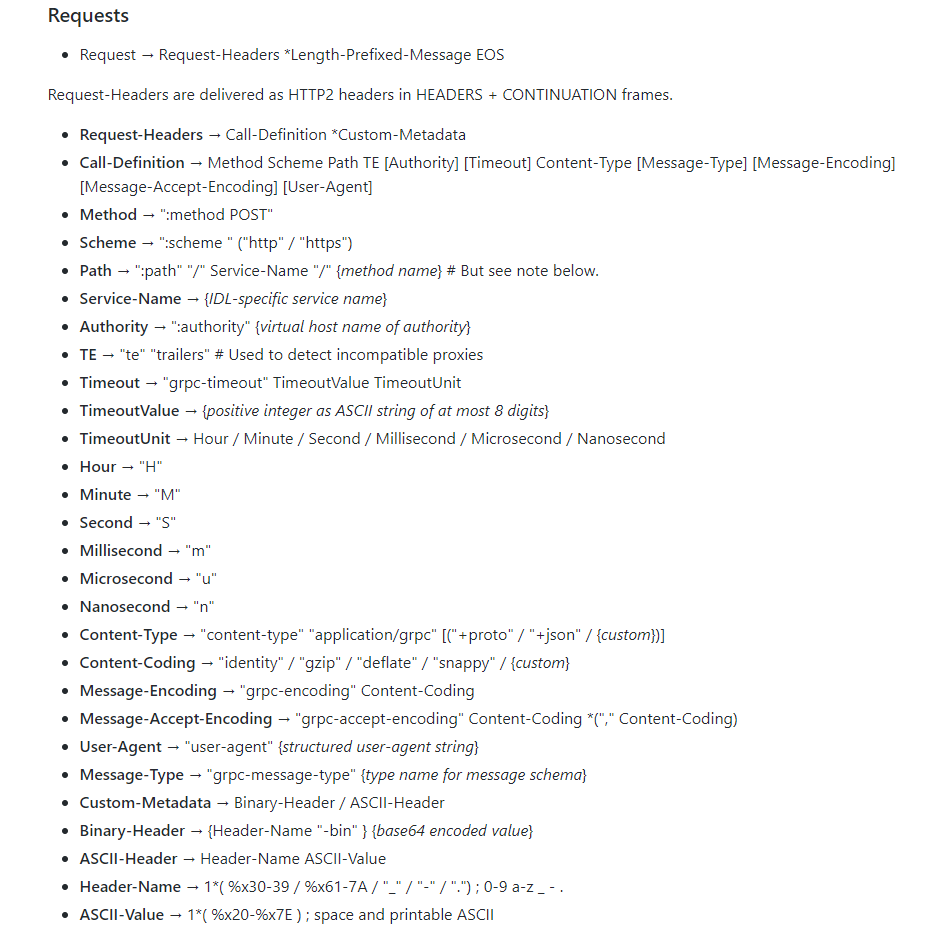阅读本文的前提是你对 grpc 协议的编解码和 协议打解包过程都比较清楚了,假如不是很了解可以先去阅读 《10 - grpc 协议编解码器》 和 《11 - grpc 协议解包过程全剖析》
我们知道协议是一款 rpc 框架的基础。协议里面定义了一次客户端需要携带的信息,包括请求的后端服务名 ServiceName,方法名 Method、超时时间 Timeout、编码 Encoding、认证信息 Authority 等等。
前面我们已经说到了,grpc 是基于 http2 协议的,我们来看看 grpc 协议里面的一些关键信息:
可以看到,一次请求需要携带这么多信息,server 会根据 client 携带的这些信息来进行相应的处理。那么这些协议里面定义的内容要如何被传递下去呢?
为了回答上面的问题,我们需要一个数据承载体结构,来保存协议里面的一些需要透传的一些重要信息,比如 Method 等。在 grpc 中,这个结构就是 Stream, 我们来看一下 Stream 的定义。
// Stream represents an RPC in the transport layer.
type Stream struct {
id uint32
st ServerTransport // nil for client side Stream
ctx context.Context // the associated context of the stream
cancel context.CancelFunc // always nil for client side Stream
done chan struct{} // closed at the end of stream to unblock writers. On the client side.
ctxDone <-chan struct{} // same as done chan but for server side. Cache of ctx.Done() (for performance)
method string // the associated RPC method of the stream
recvCompress string
sendCompress string
buf *recvBuffer
trReader io.Reader
fc *inFlow
wq *writeQuota
// Callback to state application's intentions to read data. This
// is used to adjust flow control, if needed.
requestRead func(int)
headerChan chan struct{} // closed to indicate the end of header metadata.
headerChanClosed uint32 // set when headerChan is closed. Used to avoid closing headerChan multiple times.
// hdrMu protects header and trailer metadata on the server-side.
hdrMu sync.Mutex
// On client side, header keeps the received header metadata.
//
// On server side, header keeps the header set by SetHeader(). The complete
// header will merged into this after t.WriteHeader() is called.
header metadata.MD
trailer metadata.MD // the key-value map of trailer metadata.
noHeaders bool // set if the client never received headers (set only after the stream is done).
// On the server-side, headerSent is atomically set to 1 when the headers are sent out.
headerSent uint32
state streamState
// On client-side it is the status error received from the server.
// On server-side it is unused.
status *status.Status
bytesReceived uint32 // indicates whether any bytes have been received on this stream
unprocessed uint32 // set if the server sends a refused stream or GOAWAY including this stream
// contentSubtype is the content-subtype for requests.
// this must be lowercase or the behavior is undefined.
contentSubtype string
}
接下来我们来看看 server 端 Stream 的构造。前面的内容已经说过 server 的处理流程了。我们直接进入 serveStreams 这个方法。路径为:s.Serve(lis) ——> s.handleRawConn(rawConn) ——> s.serveStreams(st)
func (s *Server) serveStreams(st transport.ServerTransport) {
defer st.Close()
var wg sync.WaitGroup
st.HandleStreams(func(stream *transport.Stream) {
wg.Add(1)
go func() {
defer wg.Done()
s.handleStream(st, stream, s.traceInfo(st, stream))
}()
}, func(ctx context.Context, method string) context.Context {
if !EnableTracing {
return ctx
}
tr := trace.New("grpc.Recv."+methodFamily(method), method)
return trace.NewContext(ctx, tr)
})
wg.Wait()
}
最上层 HandleStreams 是对 http2 数据帧的处理。grpc 一共处理了 MetaHeadersFrame 、DataFrame、RSTStreamFrame、SettingsFrame、PingFrame、WindowUpdateFrame、GoAwayFrame 等 7 种帧。
// HandleStreams receives incoming streams using the given handler. This is
// typically run in a separate goroutine.
// traceCtx attaches trace to ctx and returns the new context.
func (t *http2Server) HandleStreams(handle func(*Stream), traceCtx func(context.Context, string) context.Context) {
defer close(t.readerDone)
for {
frame, err := t.framer.fr.ReadFrame()
atomic.StoreUint32(&t.activity, 1)
if err != nil {
if se, ok := err.(http2.StreamError); ok {
warningf("transport: http2Server.HandleStreams encountered http2.StreamError: %v", se)
t.mu.Lock()
s := t.activeStreams[se.StreamID]
t.mu.Unlock()
if s != nil {
t.closeStream(s, true, se.Code, false)
} else {
t.controlBuf.put(&cleanupStream{
streamID: se.StreamID,
rst: true,
rstCode: se.Code,
onWrite: func() {},
})
}
continue
}
if err == io.EOF || err == io.ErrUnexpectedEOF {
t.Close()
return
}
warningf("transport: http2Server.HandleStreams failed to read frame: %v", err)
t.Close()
return
}
switch frame := frame.(type) {
case *http2.MetaHeadersFrame:
if t.operateHeaders(frame, handle, traceCtx) {
t.Close()
break
}
case *http2.DataFrame:
t.handleData(frame)
case *http2.RSTStreamFrame:
t.handleRSTStream(frame)
case *http2.SettingsFrame:
t.handleSettings(frame)
case *http2.PingFrame:
t.handlePing(frame)
case *http2.WindowUpdateFrame:
t.handleWindowUpdate(frame)
case *http2.GoAwayFrame:
// TODO: Handle GoAway from the client appropriately.
default:
errorf("transport: http2Server.HandleStreams found unhandled frame type %v.", frame)
}
}
}
对于每一次请求而言,client 一定会先发 HeadersFrame 这个帧,grpc 这里是直接使用 http2 工具包进行实现,直接处理的 MetaHeadersFrame 帧,这个帧的定义为:
// A MetaHeadersFrame is the representation of one HEADERS frame and
// zero or more contiguous CONTINUATION frames and the decoding of
// their HPACK-encoded contents.
//
// This type of frame does not appear on the wire and is only returned
// by the Framer when Framer.ReadMetaHeaders is set.
type MetaHeadersFrame struct {
*HeadersFrame
Fields []hpack.HeaderField
Truncated bool
}
所以是在 MetaHeadersFrame 这个帧里去处理包头数据。所以会去执行 operateHeaders 这个方法,在这个方法里面会去构造一个 stream ,这个 stream 里面包含了传输层请求上下文的数据。包括方法名等。
s := &Stream{
id: streamID,
st: t,
buf: buf,
fc: &inFlow{limit: uint32(t.initialWindowSize)},
recvCompress: state.data.encoding,
method: state.data.method,
contentSubtype: state.data.contentSubtype,
}
构造完 stream 后,接下来 tranport 对数据的处理都会将 stream 层层透传下去。所以整个请求内所需要的数据都从 stream 中可以得到,这样就实现了 server 端的数据流转。
与 server 相对应,client 端也有一个 clientStream 结构,定义如下:
// clientStream implements a client side Stream.
type clientStream struct {
callHdr *transport.CallHdr
opts []CallOption
callInfo *callInfo
cc *ClientConn
desc *StreamDesc
codec baseCodec
cp Compressor
comp encoding.Compressor
cancel context.CancelFunc // cancels all attempts
sentLast bool // sent an end stream
beginTime time.Time
methodConfig *MethodConfig
ctx context.Context // the application's context, wrapped by stats/tracing
retryThrottler *retryThrottler // The throttler active when the RPC began.
binlog *binarylog.MethodLogger // Binary logger, can be nil.
// serverHeaderBinlogged is a boolean for whether server header has been
// logged. Server header will be logged when the first time one of those
// happens: stream.Header(), stream.Recv().
//
// It's only read and used by Recv() and Header(), so it doesn't need to be
// synchronized.
serverHeaderBinlogged bool
mu sync.Mutex
firstAttempt bool // if true, transparent retry is valid
numRetries int // exclusive of transparent retry attempt(s)
numRetriesSincePushback int // retries since pushback; to reset backoff
finished bool // TODO: replace with atomic cmpxchg or sync.Once?
attempt *csAttempt // the active client stream attempt
// TODO(hedging): hedging will have multiple attempts simultaneously.
committed bool // active attempt committed for retry?
buffer []func(a *csAttempt) error // operations to replay on retry
bufferSize int // current size of buffer
}
client 的构造就更直接了,在 invoke 发起下游调用时, 直接在 sendMsg 之前就会提前构造 clientStream, 如下:
func invoke(ctx context.Context, method string, req, reply interface{}, cc *ClientConn, opts ...CallOption) error {
cs, err := newClientStream(ctx, unaryStreamDesc, cc, method, opts...)
if err != nil {
return err
}
if err := cs.SendMsg(req); err != nil {
return err
}
return cs.RecvMsg(reply)
}
stream 这个结构承载了数据流转之外,同时 grpc 流式传输的实现也是基于 stream 去实现的。
